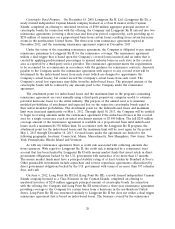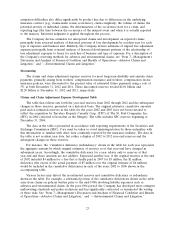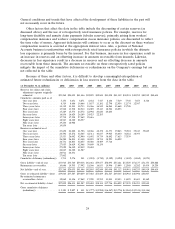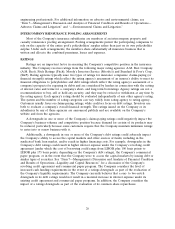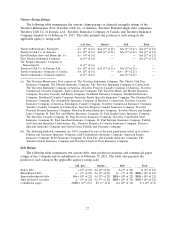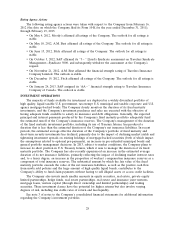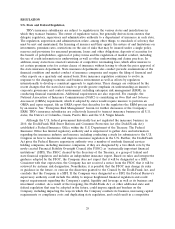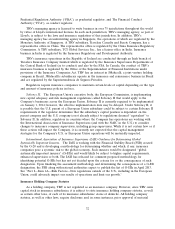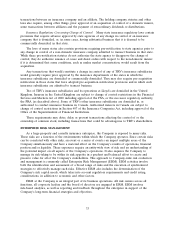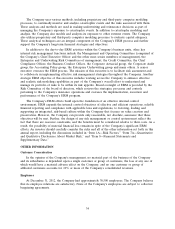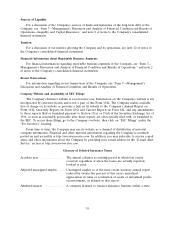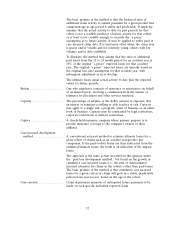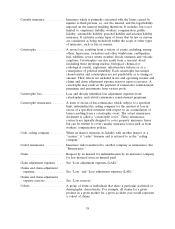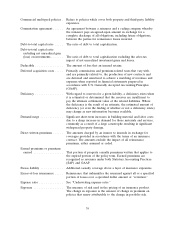Travelers 2012 Annual Report Download - page 41
Download and view the complete annual report
Please find page 41 of the 2012 Travelers annual report below. You can navigate through the pages in the report by either clicking on the pages listed below, or by using the keyword search tool below to find specific information within the annual report.REGULATION
U.S. State and Federal Regulation
TRV’s insurance subsidiaries are subject to regulation in the various states and jurisdictions in
which they transact business. The extent of regulation varies, but generally derives from statutes that
delegate regulatory, supervisory and administrative authority to a department of insurance in each state.
The regulation, supervision and administration relate, among other things, to standards of solvency that
must be met and maintained, the licensing of insurers and their agents, the nature of and limitations on
investments, premium rates, restrictions on the size of risks that may be insured under a single policy,
reserves and provisions for unearned premiums, losses and other obligations, deposits of securities for
the benefit of policyholders, approval of policy forms and the regulation of market conduct, including
the use of credit information in underwriting as well as other underwriting and claims practices. In
addition, many states have enacted variations of competitive ratemaking laws, which allow insurers to
set certain premium rates for certain classes of insurance without having to obtain the prior approval of
the state insurance department. State insurance departments also conduct periodic examinations of the
financial condition and market conduct of insurance companies and require the filing of financial and
other reports on a quarterly and annual basis. State insurance regulation continues to evolve in
response to the changing economic and business environment as well as efforts by regulators
internationally to develop a consistent approach to regulations. These changes are evidenced by the
recent changes that the states have made to provide greater emphasis on understanding an insurer’s
corporate governance and control environment, including enterprise risk management (ERM), in
conducting financial examinations. Additional requirements are also expected. For example, the
National Association of Insurance Commissioners (NAIC) is considering an Own Risk and Solvency
Assessment (ORSA) requirement, which if adopted by states would require insurers to perform an
ORSA and, upon request, file an ORSA report that describes for the regulators the ERM process used
by an insurer. See ‘‘Enterprise Risk Management’’ herein for further discussion of the Company’s
ERM. TRV’s insurance subsidiaries are collectively licensed to transact insurance business in all U.S.
states, the District of Columbia, Guam, Puerto Rico and the U.S. Virgin Islands.
Although the U.S. federal government historically has not regulated the insurance business, in
2010, the Dodd-Frank Wall Street Reform and Consumer Protection Act (the Dodd-Frank Act)
established a Federal Insurance Office within the U.S. Department of the Treasury. The Federal
Insurance Office has limited regulatory authority and is empowered to gather data and information
regarding the insurance industry and insurers, including conducting a study for submission to the U.S.
Congress on how to modernize and improve insurance regulation in the U.S. Further, the Dodd-Frank
Act gives the Federal Reserve supervisory authority over a number of nonbank financial services
holding companies, including insurance companies, if they are designated by a two-thirds vote by the
newly created Financial Stability Oversight Council (the FSOC) as ‘‘systemically important financial
institutions’’ (SIFI). The FSOC, chaired by the Secretary of the Treasury, is a group of federal and
state financial regulators and includes an independent insurance expert. Based on rules and interpretive
guidance adopted by the FSOC, the Company does not expect that it will be designated as a SIFI.
Consistent with that expectation, the Company has not received a notice from the FSOC that it will be
reviewed for systemic risk designation. Nonetheless, it is possible that the FSOC may change its rules
or guidance in the future, or exercise the discretion granted to the Council by the Dodd-Frank Act, and
conclude that the Company is a SIFI. If the Company were designated as a SIFI, the Federal Reserve’s
supervisory authority could include the ability to impose heightened financial regulation and could
impact requirements regarding the Company’s capital, liquidity and leverage as well as its business and
investment conduct. As a result of the foregoing, the Dodd-Frank Act, or other additional state and
federal regulation that may be adopted in the future, could impose significant burdens on the
Company, including impacting the ways in which the Company conducts its business, increasing capital
requirements or compliance costs and duplicating state regulation, and could result in a competitive
29



